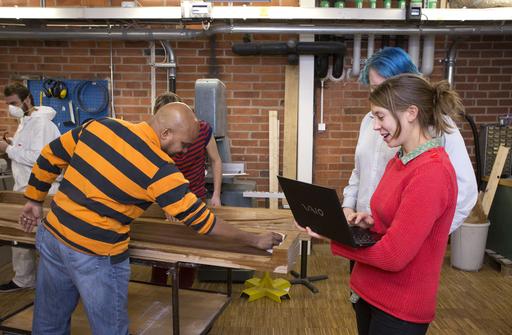Visa version
Visa
< föregående
|
nästa >
Jämför
< föregående
|
nästa >
1.3.3 Unmanned, solar-powered boats win Japanese challenge
1.3.3 Unmanned, solar-powered boats win Japanese challenge
The Naval Design course at KTH challenges its students to develop a solar-powered boat for a competition in Japan. The project is both a technological and cultural challenge during which the students work together with Japanese students to put their designs into practice. In 2013 the students exceeded all expectations by finishing in first and second place in the competition – and in 2014 a new group of students is aiming to emulate this success.

Students working on developing the solar powered boat.
The competition is won by the boat that completes a twenty kilometre course on Lake Biwa in Japan in the shortest time. The boat must be able to pilot itself during the competition – the students are not allowed to give the craft any commands during its voyage. The craft must also be able to complete the course using no other source of energy than the sun and a limited supply of batteries.
The Swedish students worked intensively over four months to develop the design to complete the first part of the course. They divided into three groups, each group working in parallel with different aspects of the project. One group worked on the hull, one group worked on propulsion and one group worked on the control system. In addition they collectively shared the responsibility for communicating with the Japanese students and for finding a sponsor to finance their journey to Japan in August.
When the Swedish students arrived in Japan they built the new boat – a catamaran – together with their Japanese project counterparts. They also worked together to build a boat of a type that had already taken part in the competition in 2012. The cultural differences were obvious, but the trip would be a memory to last a lifetime. The students stayed in a typical Japanese ryokan, slept on tatami mats and ate rice, fish and miso soup for breakfast.
When the competition began it soon became apparent that the boats were up to the job. They claimed the first two places. The experiences of the Swedish students form an important lesson for the following year's students to learn from, as the course will take part in the competition again.
Through harvesting the experiences of students from the previous year, the collaboration with the Japanese university becomes more efficient. This year’s project has been initiated earlier, which is an advantage. Other advantages are that the project will be able to test the boats at a University of Tokyo testing facility and it is also planned that the students will have more time in Japan to prepare for the competition. .
In addition the new project group is planning a partially new technological solution. The new boat will 'fly' on wing-like supports that will lift the new single-hull out of the water – with the intention of reducing the friction between the boat and the water, and consequently reducing energy consumption. A new automatic control system will maintain the hull at certain height from the surface of the water. The students will also design a new propulsion system, using new solar panels and propellers.
It is creativity that takes the driving seat during the project. The only certainties are the prerequisites: the rules of the competition, how large the solar panels can be and so on. The solutions are limited only by the imagination of the students, their level of commitment and their ability to work together.
Additional information: http://kthsolarboat.se/index.php